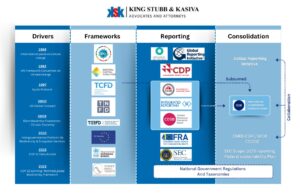King, Stubb & Kasiva | View firm profile
ESG disclosure frameworks convergence is a business accountability tipping point. As the International Sustainability Standards Board (ISSB) leads global convergence, the ultimate question persists: Will this rush toward global convergence increase sustainability practice or miss important regional and sectoral concerns?
ESG Transformation:
- Evolution of Reporting Drivers: ESG reporting has its roots in global climate agreements, evolving from the Kyoto Protocol’s focus on emissions to the Paris Agreement’s broader climate commitments. Initiatives such as the UN Global Compact and COP15 on biodiversity have further shaped corporate disclosure norms, linking transparency with climate resilience, environmental responsibility, and sustainable resource management.
- Standards Complexity: Companies have been grappling for decades with a siloed framework ecosystem—TCFD for climate risk, TNFD for nature impacts, GRI for overall sustainability metrics, and SASB for industry-level information.
- Industry-Specific ESG Expectations: A sector-based approach to ESG reporting is gaining traction. The SASB framework, EU Taxonomy, and TNFD recognize that material ESG risks differ across industries (e.g., biodiversity concerns in agriculture vs. carbon footprint in manufacturing). This shift moves ESG from a one-size-fits-all model to industry-customized metrics.
- Greenwashing Crackdowns and ESG Assurance: With growing concerns about greenwashing, regulatory bodies are introducing stricter scrutiny of ESG claims. The EU Green Claims Directive, India’s SEBI ESG ratings framework, and SEC’s ESG Fund Rules are demanding greater transparency, third-party assurance, and standardized methodologies to validate sustainability claims.
- Transition from ESG to Impact-Driven Investing: ESG investing is evolving beyond screening for sustainability risks. Impact-driven investing focuses on measurable outcomes, such as carbon reduction, biodiversity restoration, or social equity improvements.
- Technology’s Role in ESG Data & Reporting: Companies are leveraging automated data collection, real-time ESG tracking, and blockchain-based supply chain verification to enhance the accuracy and reliability of disclosures. This digital transformation is reducing manual reporting burdens and improving data integrity.
The Road Ahead: Balancing Ambition with Pragmatism
Whereas harmonization guarantees efficiency, the ESG ecosystem can stagnate if fundamental principles are sacrificed. To encourage meaningful progress, future frameworks need to:
- Prioritize environmental/social rigor over standardized convenience.
- Align investor-focused metrics with environmental/societal effects (GRI, TNFD, EU regulations).
- Prioritize meaningful progress over short-term investor narratives.
- Keep flexibility for sectors like energy or agriculture, whose sustainability challenges differ fundamentally.
Global alignment needs to facilitate—not hinder—sustainability innovation. The real proof is if and only if these standards drive quantifiable environmental/social outcomes and not merely enable flash sustainability PR. Let us leave ESG reporting as a flag for transformation and not as a corporate scoreboard.
